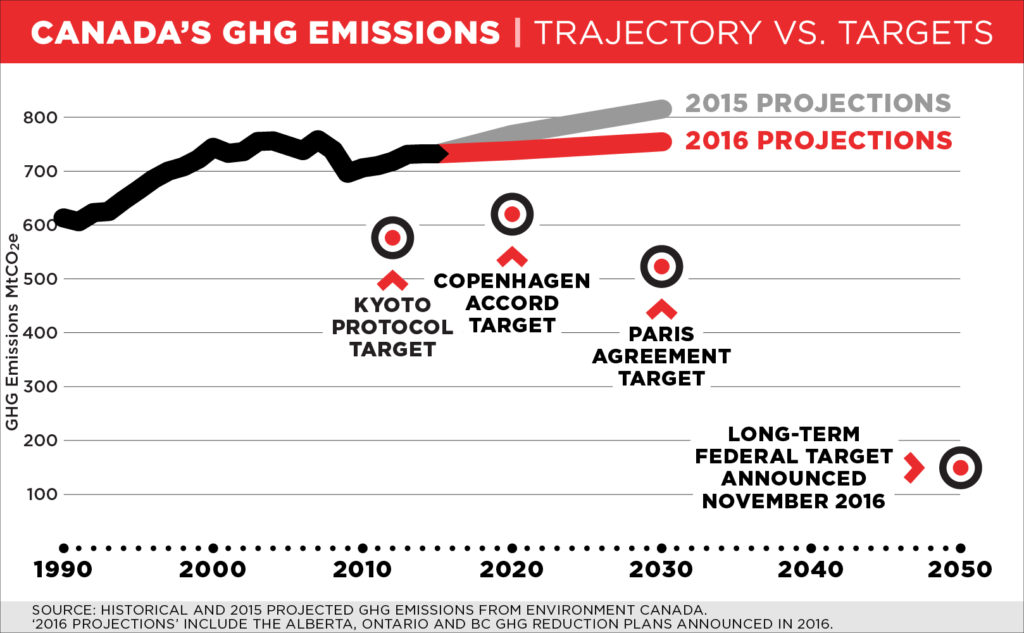“There is a huge gap—an ambition gap—between where we are and where we need to be to meet even our modest international commitments.”
So says my contribution, with David Macdonald, to Maclean’s annual list of economic trends Canadians should be watching in the coming year. In our view, the actions Canadian governments take—or fail to take—on climate policy in 2017 will determine not only whether Canada can feasibly meet its commitments to reduce greenhouse gas (GHG) emissions in the medium- to long-term, but will also determine the shape of our economy for years to come.
This blog unpacks those ideas in a bit more detail than the Maclean’s format allowed.
Understanding the climate challenge
First, a few points of context:
- Climate change is real and is already affecting millions of people across the globe.
- Climate change is mainly caused by human activity (mostly from the emission of greenhouse gases from the combustion of fossil fuels).
- Climate change is going to get a lot (read: catastrophically) worse, including for the economy, in the absence of serious global efforts to reduce GHG emissions.
- The international community has committed to reducing GHG emissions to limit further changes to the climate.
- As one of the worst per capita GHG emitters in the world (and biggest overall emitters), Canada has a clear obligation to reduce its total emissions.
Canada is slowly beginning to move on that obligation. Importantly, our federal government has committed to a series of national GHG reduction targets—weak as they are—to guide climate policy in the country. We’ve included those targets in the chart we prepared for the Maclean’s list:

Canada’s targets are indicated by the circles on the chart. The black line illustrates our historical emissions, the grey line illustrates where are emissions were projected to go based on policies in place in 2015, and the red line is our adjustment to the 2015 projections based on the new policies announced in Alberta, Ontario and British Columbia in 2016. The red line does not reflect the pan-Canadian climate framework announced last week, which I’ll get to below.
The “ambition gap” we’re talking about is the space between the lines and the circles—the gap between our promises and our policies.
You might notice that Canada has already missed one target (by about 20%). Technically the Harper government withdrew from the Kyoto Protocol before the target was officially “missed,” but it’s nonetheless a milestone worth noting. If we had upheld our Kyoto commitment Canada would be in far better shape than we find ourselves today.
Alas we did not, so our subsequent targets will be that much harder to hit. Canada emitted 732 megatonnes (Mt) of greenhouse gases in 2014. Based on our adjusted projections, Canada is headed for around 750 Mt of GHG emissions by 2030. That means we will miss both our 2020 target (of 620 Mt) and our 2030 target (of 523 Mt) by huge margins. Canada’s 2050 target of 80% below 2005 levels (150 Mt) is a total pipe(line) dream based on current policies.
What does this have to do with the economy?
To close the ambition gap, Canada’s federal and provincial governments will need to restructure their economies to reduce GHG emissions. We’re talking a war-scale economic transformation to eliminate high-emitting economic activities and replace them with low-carbon alternatives. That includes policies to:
- Replace fossil fuel-based electricity generation with non-emitting renewables.
- Replace fossil fuel-burning vehicles with non-emitting electric models.
- Restructure urban areas to increase walkability and public transit use.
- End the carbon-intensive extraction of dirty fuels like the oil sands.
- Drastically improve energy efficiency in homes and workplaces.
And that’s just the start. In other words, if Canadian governments are serious about putting Canada on a pathway to deep decarbonisation, their policies will have huge implications for the economy, too.
The new federal-provincial climate plan
The new Pan-Canadian Framework on Clean Growth and Climate Change deserves a post of its own, but the key takeaway is that Canadian governments’ climate policies still have some way to go before they align with the climate rhetoric. That’s not to downplay significant progress; the new national plan is unprecedented and, if implemented, will drive significant reductions in emissions across the country. But even by the federal government’s own optimistic calculations (and despite the inclusion of dubious carbon offsets), the new plan still falls short of the 2030 target while ignoring the 2020 target completely.
So what are we watching for in 2017? We’re watching for the line that isn’t on the chart yet: the “2017 projections” line. We’re watching because it’s still possible that through new policies at the federal and provincial level we can push that line down far enough to meet our commitments.
It’s going to take more than just ambitious targets and encouraging rhetoric. It’s going to take difficult choices and real climate leadership from every government in Canada. But with the pan-Canadian framework now underfoot, all the tools are in place for governments to ratchet up their policy ambitions to the necessary level. Let’s hope 2017 is the year they do.
Hadrian Mertins-Kirkwood is an international trade and climate policy researcher at the CCPA. Follow Hadrian on Twitter @hadrianmk.






